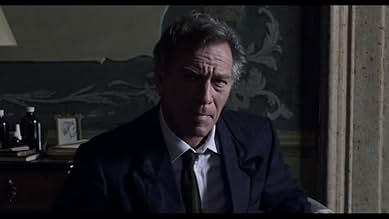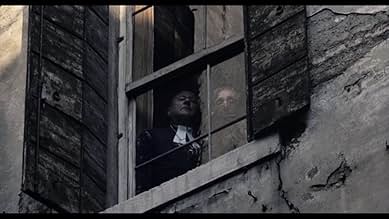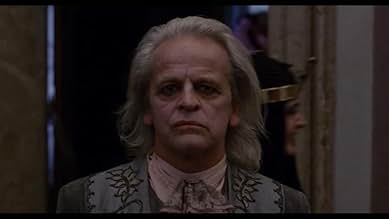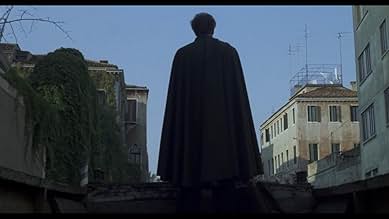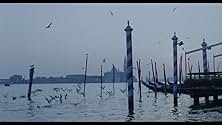PUNTUACIÓN EN IMDb
5,1/10
1,9 mil
TU PUNTUACIÓN
El profesor Paris Catalano visita Venecia para investigar la última aparición conocida del famoso vampiro Nosferatu durante el carnaval de 1786.El profesor Paris Catalano visita Venecia para investigar la última aparición conocida del famoso vampiro Nosferatu durante el carnaval de 1786.El profesor Paris Catalano visita Venecia para investigar la última aparición conocida del famoso vampiro Nosferatu durante el carnaval de 1786.
- Dirección
- Guión
- Reparto principal
Maria Cumani Quasimodo
- Princess
- (as Maria Clementina Cumani Quasimodo)
La Chunga
- Woman at Gypsy Camp
- (as Micaela Flores Amaya 'La Chunga')
Mickey Knox
- Priest
- (sin acreditar)
Reseñas destacadas
Nosferatu (dir. F. W. Murnau, 1922) is regarded as a masterpiece. To be honest, I enjoyed Werner Herzog's remake (1979) far more - Klaus Kinski's performance in the title role was perfect; repellent and charismatic in equal measure. So I've been looking forward to seeing this hard-to-get-hold-of "sequel" for years.
Oh dear, what a disappointment. This film is a confused mess.
If "Vampire in Venice" were less conventional, it could be Art-house or Surrealist Cinema. And then its fogginess might be to its advantage. But... it just isn't.
Whereas its' predecessors were directed with a spark of genius, "Vampire in Venice" had a history of directorial dithering - and boy does it show. Despite some excellent cinematography, great sets and a (potentially) strong cast, the film is so weakly directed that it falls apart almost immediately. The cast is wasted. The plot is incongruous. The characters are under-developed and their motivations are anyones' guess. The whole is deeply unsatisfying. Of course, Barabara De Rossi is utterly gorgeous, Plummer has some gravitas and Kinski is OK, but without a firm hand at the rudder, we are on a gondola to nowhere.
Only the film's few saving graces allowed me to watch to the end. One for the curious only, I fear.
Oh dear, what a disappointment. This film is a confused mess.
If "Vampire in Venice" were less conventional, it could be Art-house or Surrealist Cinema. And then its fogginess might be to its advantage. But... it just isn't.
Whereas its' predecessors were directed with a spark of genius, "Vampire in Venice" had a history of directorial dithering - and boy does it show. Despite some excellent cinematography, great sets and a (potentially) strong cast, the film is so weakly directed that it falls apart almost immediately. The cast is wasted. The plot is incongruous. The characters are under-developed and their motivations are anyones' guess. The whole is deeply unsatisfying. Of course, Barabara De Rossi is utterly gorgeous, Plummer has some gravitas and Kinski is OK, but without a firm hand at the rudder, we are on a gondola to nowhere.
Only the film's few saving graces allowed me to watch to the end. One for the curious only, I fear.
In VAMPIRE IN VENICE, Professor Paris Catalano (Christopher Plummer) is obsessed with tracking down the infamous blood-drinker of the title (Klaus Kinski). When Catalano finds a strange family in Venice, who were originally from Transylvania, he believes he's hit pay dirt.
This leads to the backstory being told, while Donald Pleasence makes an appearance.
When a medium is called in, resulting in a seance, the so-called "Prince of Putridity" returns! Death and doom are the result!
Kinski is quite convincing and threatening in his undead role. His interesting facial features have always made him the perfect villain, whether in horror or crime thrillers. He pulls off being pure eeevil with ease! Plummer is doggedly heroic as the Van Helsing-like Catalano.
While not a bad movie, it does tend to drag on interminably in spots...
This leads to the backstory being told, while Donald Pleasence makes an appearance.
When a medium is called in, resulting in a seance, the so-called "Prince of Putridity" returns! Death and doom are the result!
Kinski is quite convincing and threatening in his undead role. His interesting facial features have always made him the perfect villain, whether in horror or crime thrillers. He pulls off being pure eeevil with ease! Plummer is doggedly heroic as the Van Helsing-like Catalano.
While not a bad movie, it does tend to drag on interminably in spots...
Nosferatu in Venice (1988)
** (out of 4)
Klaus Kinski returns to the role of Nosferatu in this Italian film that was originally suppose to be a follow-up to Herzog's 1979 film. After various production issues including two director's being fired, the film ended up pretty much being 100% on its own with the only connection to the earlier film being Kinski. In the film, vampire hunter Paris Catalano (Christopher Plummer) travels to Venice, the last known location of the vampire Nosferatu (Kinski). Catalano tries to locate the whereabouts of the vampire who he believes has a desire to finally die. This is a rather interesting failure that has a lot going for it but it's obvious the production issues caused a lot of problems especially during the first part of the movie. The film starts off very ambitious as it centers on the Plummer character in current times but we then have several flashbacks to the earlier days of Nosferatu and how he became who he is. This was an interesting idea but it never really works for several reasons and one of them is a bizarre rock score that doesn't fit anything we see. Another reason these flashbacks never work is because at times it's hard to follow what exactly is going on and why certain flashbacks might be happening. Then, around the fifty-minute mark, something strange happens and the film actually turns extremely entertaining as Nosferatu finds himself in current times and falling in love with a young black lady who might just hold the key to his eventual death. Yes, Kinski drove several directors away from the film and this is partly to blame of the uneven film but you also have to give him credit because he turns in a great performance. He has his long blonde hair flowing and there's no chalk make-up so we get to see this Nosferatu in a very human-like state and the actor makes us feel sorry for this person who simply won't die. I found Kinski really intense throughout the film and this certainly spills over for several entertaining scenes but I think the romantic side works the best. Plummer is also pretty good in his rather thankless role and we even get Donald Pleasence in a role but he's pretty much wasted. Barbara De Rossi and Anne Knecht are both good as the ladies in the pack. Augusto Caminito, Mario Caiano, Luigi Cozzi and Maurizio Lucidi all did some work on the film but it was Caminito who ended up shooting the majority of the film. Even Kinski was apparently in charge of directing his scenes so who knows what was really going on with this production. It's certainly a very troubled movie but at the same time there's just so much here that does work in the end. We get some rather strong atmosphere and being 1988 and from Italy, there's much more sex, nudity and blood than normal, which is a plus. I doubt art house fans are going to enjoy this thing but if you're a horror fan and like Kinski then it would be worth your time to check this out. It's certainly not going to replace the Herzog film but it's an interesting little movie.
** (out of 4)
Klaus Kinski returns to the role of Nosferatu in this Italian film that was originally suppose to be a follow-up to Herzog's 1979 film. After various production issues including two director's being fired, the film ended up pretty much being 100% on its own with the only connection to the earlier film being Kinski. In the film, vampire hunter Paris Catalano (Christopher Plummer) travels to Venice, the last known location of the vampire Nosferatu (Kinski). Catalano tries to locate the whereabouts of the vampire who he believes has a desire to finally die. This is a rather interesting failure that has a lot going for it but it's obvious the production issues caused a lot of problems especially during the first part of the movie. The film starts off very ambitious as it centers on the Plummer character in current times but we then have several flashbacks to the earlier days of Nosferatu and how he became who he is. This was an interesting idea but it never really works for several reasons and one of them is a bizarre rock score that doesn't fit anything we see. Another reason these flashbacks never work is because at times it's hard to follow what exactly is going on and why certain flashbacks might be happening. Then, around the fifty-minute mark, something strange happens and the film actually turns extremely entertaining as Nosferatu finds himself in current times and falling in love with a young black lady who might just hold the key to his eventual death. Yes, Kinski drove several directors away from the film and this is partly to blame of the uneven film but you also have to give him credit because he turns in a great performance. He has his long blonde hair flowing and there's no chalk make-up so we get to see this Nosferatu in a very human-like state and the actor makes us feel sorry for this person who simply won't die. I found Kinski really intense throughout the film and this certainly spills over for several entertaining scenes but I think the romantic side works the best. Plummer is also pretty good in his rather thankless role and we even get Donald Pleasence in a role but he's pretty much wasted. Barbara De Rossi and Anne Knecht are both good as the ladies in the pack. Augusto Caminito, Mario Caiano, Luigi Cozzi and Maurizio Lucidi all did some work on the film but it was Caminito who ended up shooting the majority of the film. Even Kinski was apparently in charge of directing his scenes so who knows what was really going on with this production. It's certainly a very troubled movie but at the same time there's just so much here that does work in the end. We get some rather strong atmosphere and being 1988 and from Italy, there's much more sex, nudity and blood than normal, which is a plus. I doubt art house fans are going to enjoy this thing but if you're a horror fan and like Kinski then it would be worth your time to check this out. It's certainly not going to replace the Herzog film but it's an interesting little movie.
I'm a tremendously massive fan of the works and persona of Klaus Kinski, but apparently I should praise myself lucky that I never had to work with him or maybe even meet with him person. Kinski allegedly was an incredibly arrogant individual and literally an impossible person to interact with professionally. During this particular period – the late 80s – he also was at the heights of his violent temper, which (nearly) ruined all the movies he starred in. Director David Schmoeller made the ironic short film "Please Kill Mr. Kinski", based on the disastrous experience that he had with him during "Crawlspace" in 1986 and even the long-running professional relationship with the acclaimed director Werner Herzog got destroyed in 1987 during the filming of "Cobra Verde". According to the documentaries Herzog and Kinski got into several vicious fights and openly threatened to kill each other. Also this "Nosferatu in Venice" suffered enormously from Kinski's eccentric quirks. He chased away the initially hired director Mario Caiano, he physically assaulted two of the lead actresses and he refused to cut his hair or wear any make-up. And yet, it's a Kinski film and I'd move heaven and earth just to see it!
I liked "Nosferatu in Venice" a lot, but not exactly because it's a good film I'm much more fond of the whole idea and concept of the film. What a brilliant idea to set a vampire movie in the wonderful city of Venice! And not just any ravenous and mad-as-hell vampire, but a melancholic vampire figure like Nosferatu! That's just fantastic. The story initially follows Prof. Catalano, who's searching for the mysteriously vanished Nosferatu, but at the same time the professor is convinced that he is fed up with his immortal and roaming existence. Deep in the basement of a Venetian family mansion there is a tomb, and the heiress thinks that Nosferatu is buried here. They hold a séance to awaken him, but he resurrects somewhere on a tropical island. Nosferatu promptly travels to Venice, hoping to find love and eternal peace. "Noferatu in Venice" is slow-brooding and talkative, and thus definitely not recommended for the nowadays new generation of horror/vampire movie fanatics that swear by fancy computer-generated effects and monstrous transformations. This movie thrives on macabre atmosphere, moody set-pieces and sober cinematography. The plot is very messy and often doesn't make a lick of sense, and yet it's captivating from start to finish. This is also a very unconventional vampire story. Kinski's Nosferatu doesn't suck the blood from the virgin's necks, but he impales old ladies on fences and tears off the lips of jealous boyfriends. Kinski doesn't have to do a lot apart from demonstrating his naturally sinister charisma. The cast contains another two phenomenal actors, Donald Pleasance and Christopher Plummer, as well as a couple of beautiful actresses, like Barbara De Rossi.
I liked "Nosferatu in Venice" a lot, but not exactly because it's a good film I'm much more fond of the whole idea and concept of the film. What a brilliant idea to set a vampire movie in the wonderful city of Venice! And not just any ravenous and mad-as-hell vampire, but a melancholic vampire figure like Nosferatu! That's just fantastic. The story initially follows Prof. Catalano, who's searching for the mysteriously vanished Nosferatu, but at the same time the professor is convinced that he is fed up with his immortal and roaming existence. Deep in the basement of a Venetian family mansion there is a tomb, and the heiress thinks that Nosferatu is buried here. They hold a séance to awaken him, but he resurrects somewhere on a tropical island. Nosferatu promptly travels to Venice, hoping to find love and eternal peace. "Noferatu in Venice" is slow-brooding and talkative, and thus definitely not recommended for the nowadays new generation of horror/vampire movie fanatics that swear by fancy computer-generated effects and monstrous transformations. This movie thrives on macabre atmosphere, moody set-pieces and sober cinematography. The plot is very messy and often doesn't make a lick of sense, and yet it's captivating from start to finish. This is also a very unconventional vampire story. Kinski's Nosferatu doesn't suck the blood from the virgin's necks, but he impales old ladies on fences and tears off the lips of jealous boyfriends. Kinski doesn't have to do a lot apart from demonstrating his naturally sinister charisma. The cast contains another two phenomenal actors, Donald Pleasance and Christopher Plummer, as well as a couple of beautiful actresses, like Barbara De Rossi.
A vampire hunter (Christopher Plummer) goes to Venice where the infamous vampire Nosferatu (Klaus Kinski) was last seen 2 centuries ago, and soon Old Two Teeth starts biting necks again, as old habits die hard. Traditional methods like sunlight or the sign of the cross do not scare Nosferatu, but it is said the love of a virgin might be dangerous to him, is any of the ladies interested?
It's not a good movie, it's not a bad movie, it simply is a pile of various bits and pieces, ranging from genius to rubbish. After several directors were fired, producer Caminito finished the movie somehow - I imagine it must have been a case of "it's better to make a painful break than draw out the agony". Venice, however, is a perfect setting for a vampire movie with its ancient, dark, decaying buildings. The warm, colorful carnival scenes provide stark contrast for the cold blue light of the early morning chases when Nosferatu is looking for victims. Unfortunately, when the tension is rising, often something ridiculous happens, for example the attempt to shoot the vampire with a shotgun (results in a cannonball hole to see through) which will immediately destroy the efforts. It's too clumsy to appeal to an art movie audience (who may have enjoyed Herzog's Nosferatu) and too confusing to be Saturday night fun for horror flick fans. Under the circumstances of its production, it's no surprise that 'Nosferatu a Venezia' failed, but I admit it is at least an interesting failure which is not just another vampire movie.
I watched the Italian language DVD which has no subtitles in other languages.
It's not a good movie, it's not a bad movie, it simply is a pile of various bits and pieces, ranging from genius to rubbish. After several directors were fired, producer Caminito finished the movie somehow - I imagine it must have been a case of "it's better to make a painful break than draw out the agony". Venice, however, is a perfect setting for a vampire movie with its ancient, dark, decaying buildings. The warm, colorful carnival scenes provide stark contrast for the cold blue light of the early morning chases when Nosferatu is looking for victims. Unfortunately, when the tension is rising, often something ridiculous happens, for example the attempt to shoot the vampire with a shotgun (results in a cannonball hole to see through) which will immediately destroy the efforts. It's too clumsy to appeal to an art movie audience (who may have enjoyed Herzog's Nosferatu) and too confusing to be Saturday night fun for horror flick fans. Under the circumstances of its production, it's no surprise that 'Nosferatu a Venezia' failed, but I admit it is at least an interesting failure which is not just another vampire movie.
I watched the Italian language DVD which has no subtitles in other languages.
¿Sabías que...?
- CuriosidadesProducer Augusto Caminito originally hired director Maurizio Lucidi, who shot a few crowd scenes in Venice before the script had even been completed. Caminito decided that the project needed another director and fired Lucidi (paying him his full salary), hiring Pasquale Squitieri to write and direct the picture. However, Squitieri's screenplay proved too expensive to shoot so Caminito decided to stop working with him (he nevertheless paid him his full, hefty, salary). Shooting had already been postponed several times and the Italian TV network which co-produced the film was getting nervous. So Caminito hired a third director, B-movie veteran Mario Caiano, and shooting could start. On his first day, Klaus Kinski got into a violent argument with Caiano and refused to work with him. The director then agreed to leave the set (after being paid his full salary), the third director to leave the picture before principal photography was complete. Facing disaster, producer Augusto Caminito then decided to direct the film himself so he wouldn't have to pay another director. Since he had almost no directing experience, he was helped by his assistant Luigi Cozzi. Kinski also reportedly directed some scenes himself.
- PifiasWhile reading from the old text, Christopher Plummer pronounces the word "compare" as "com-pair," following English pronunciation. However, the Latin or Italian word "compare" should be pronounced "com-pa-reh," with each syllable distinctly enunciated and the final "e" softly pronounced. In Italian, "compare" means "godfather" or "companion," and the mispronunciation is particularly noticeable, given the historical and linguistic context of the text.
- ConexionesFeatured in FantastiCozzi (2016)
Selecciones populares
Inicia sesión para calificar y añadir a tu lista para recibir recomendaciones personalizadas
- How long is Vampire in Venice?Con tecnología de Alexa
Detalles
- Duración
- 1h 37min(97 min)
- Mezcla de sonido
- Relación de aspecto
- 1.85 : 1
Contribuir a esta página
Sugerir un cambio o añadir el contenido que falta

